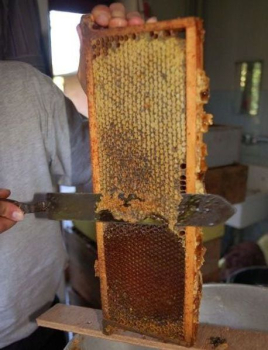
When to harvest honey
--- various people including my mother and friends
 Like many aspects of homesteading life,
beekeeping is a long term endeavor. A new package of honeybees is
a very small colony, and they spend a lot of their energy in the first
year beefing up into a regular size colony. If you do everything
right, they'll put away enough honey to get through the winter, but
they won't have much to spare. So, we don't plan to harvest any
honey until next fall.
Like many aspects of homesteading life,
beekeeping is a long term endeavor. A new package of honeybees is
a very small colony, and they spend a lot of their energy in the first
year beefing up into a regular size colony. If you do everything
right, they'll put away enough honey to get through the winter, but
they won't have much to spare. So, we don't plan to harvest any
honey until next fall.
Many American beekeepers harvest a lot of honey immediately, planning
to feed their bees sugar water or corn syrup to keep them going through
the late winter and early spring. We did feed our new
package bees sugar water, but I consider sugar water feeding a last
ditch effort afterwards. My gut reaction is that sugar water for
honeybees is a lot like corn chips for humans --- tasty, but not
fulfilling all of their nutritional needs. Instead, I want to
overcompensate and make sure they have plenty of honey to last them
until the first nectar flow next spring.
I read on one website that the modern tradition of harvesting honey in
late summer or early autumn is a recent invention. Supposedly,
beekeepers traditionally harvested honey in mid spring after the first
nectar flow began so that the beekeeper could be sure that the honey
they were taking was truly excess. Of course, you can't do this
if you use chemical mite control over the winter, but otherwise this
option seems to make a lot of sense.
Shame-faced plug: Check out the chicken
waterer that funds this blog.
Want more in-depth information? Browse through our books.
Or explore more posts by date or by subject.
About us: Anna Hess and Mark Hamilton spent over a decade living self-sufficiently in the mountains of Virginia before moving north to start over from scratch in the foothills of Ohio. They've experimented with permaculture, no-till gardening, trailersteading, home-based microbusinesses and much more, writing about their adventures in both blogs and books.
Want to be notified when new comments are posted on this page? Click on the RSS button after you add a comment to subscribe to the comment feed, or simply check the box beside "email replies to me" while writing your comment.
